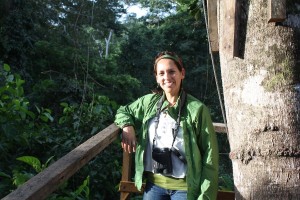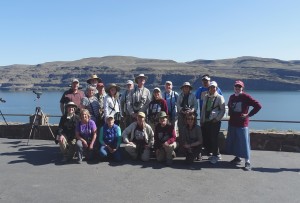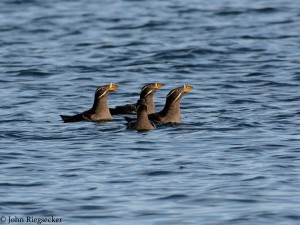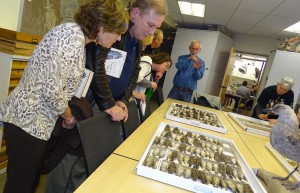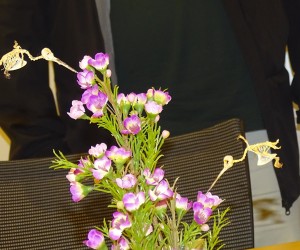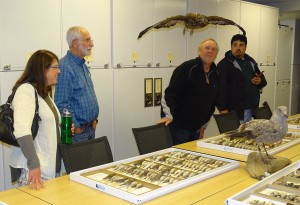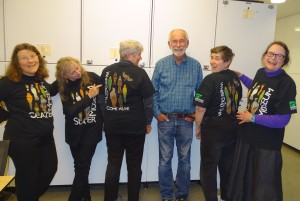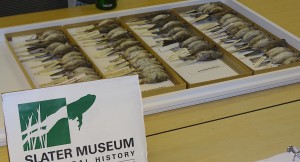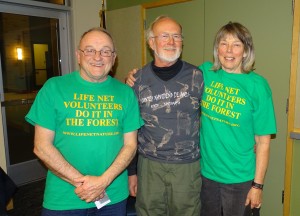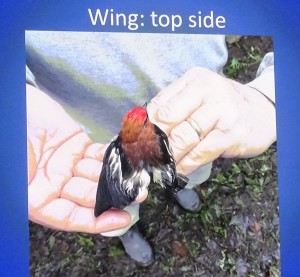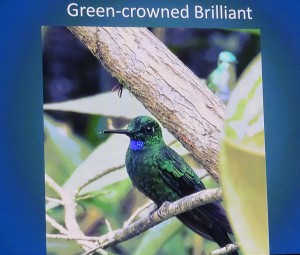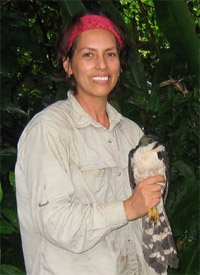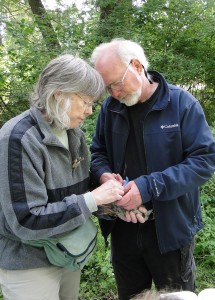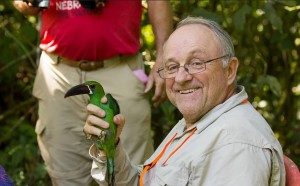ABC Pelagic Cruise
15 birders gathered at the LA World Cruise Center to board the Ruby Princess departing at 4 PM on May 3rd. For many of us it was a first cruise experience and with lifers in our dreams we set sail from LA headed north to Victoria and then Vancouver.
Day one we were all excited as we left port and were hoping for some near shore SoCal specialties like Black-vented shearwater and Scripp’s murrelet. Neither happened but we did discover how physically challenging it is to stand on the ship railing scanning with our spotting scopes for distant birds. We made it until dark, but were grateful for darkness as an excuse to call it a day. We did manage both Ashy and Leach’s storm petrel, Black-footed albatross, Sooty ad Pink-footed shearwaters, Elegant and Caspian terns, Western and California gulls, and Cassin’s aucklet. Many of us were in rooms near the front of the boat on the 9th floor, and birding is from the bow on the 7th floor deck, so getting to our rooms from the birding area was a relatively short walk.
Day 2 we were up early, meeting at the bow at 6 AM and many of us opening the 15th floor buffet breakfast room at 5 AM. The breakfast was fine. We also had dinner late at this area on the first night. Day 2 started very birdy for about the first hour, with large numbers of Leach’s storm-petrel, Sooty and Pink-footed shearwaters, and Brian Pendleton spotted a Laysan’s albatross cross the bow just before the rest of us arrived. For the next 4 hours we struggled to find many birds. We took a lunch break a little after noon, and as Ken, Bruce and I finished eating Kathryn Cooper told us about the birders having Cook’s Petrel being sighted. We rushed back to the bow area, and on arrival a Murphy’s petrel was being seen, and we all relocated it and got good looks, but no Cook’s seen initially. Throughout the afternoon we had fairly steady bird activity, with good numbers of Cook’s petrel seen well by all, another Murphy’s giving close views, but the highlight was a close fly by of a Hawaiian Petrel. We were able to see the all dark above markings, the black cap, and the heavier stronger flight pattern of this bird.
About 2:30 I mentioned to Ken that it was past time I get my life Laysan’s albatross, as we were getting good numbers of Black-footed. Not five minutes later I spotted a Laysan’s fly so close to the bow that I had to lean over the railing to get a good look. It flew right by us with everyone getting great looks. By 5 PM we were all exhausted, sore from standing, cold, and called it a day.
I slept well but many ABCers were kept awake by loud sounds form the ship. It turns out that winds were so strong that the ship had to stop for a while in the night. The reason is not certain, but one possible explanation was that “stabilizers” had to be extended due to the high winds. Whatever the reason for the noises, the captain changed course to run much closer to shore, approximately 35-40 miles off shore, not the expected 100. Winds were reported on the ship’s TV as 40-63 knots with 11 foot seas and this seemed to match the feel on the deck.
This may have been a part of the reason we had lots of Common murres, only a few Parakeet auklets, and those were tough to see, and only 2 Murphy’s petrels. There were very large numbers of Sooty shearwaters but relatively few Pink-footed. We did get a Laysan Albatross near the end of the day for an Oregon sighting. After dinner Ken and I joined Brian Pendleton, John Anderson (Olympia addition to our trip) and Brian Sullivan and his 4 person contingent for a last 30 minutes of birding after we entered Washington waters. Unfortunately it was not at all birdy, with just 2 Cassin’s aucklets and four Phalaropes. Fortunately I was able to ID one of them at a Red phalarope because it was nearly fully in alternate plumage and red below.
We were all disappointed that when the sun rose on Day 4 we were already well into the Strait of Juan de Fuca and so there was no chance for deep water birds in WA. Still it was a really nice morning to socialize with both each other and the other birders on the boat. The level of both talent and great personalities out with us was truly extraordinary.
Some of us used our half day in Victoria to chase a reported Red-throated Pipit (not found) at Panama Flats where we did see two breeding plumage Pacific Golden Plovers, and to see the Sky Larks still hanging on near the Victoria Airport.
We all got back on board in time to go to sleep, get up early and arrive at Vancouver at 7:30 AM.
Starting with Brian Sullivan the leader of 4 outstanding non-millennial birders the talent around us was truly extraordinaty. Brian was truly an expert pelagic birder and was generous with both his time and giving away copies of his new book, Offshore Wildlife ID Guide: West Coast, Check it out. It is a must have for non-experts in any aspect of offshore bird, mammal, fish or turtles. The link is to Amazon where you can buy it.
Dorian Anderson of the Biking Big Year notoriety kept us smiling with his stories and was a strong addition to the birding expertise in addition. He is planning a book about his year on the bike. It sounds like a book club book, maybe next year.
A local young man, Christian Hagenlocher, is doing a big year who was always sharing his new 90mm Swarovski scope and helping get us onto birds. He was both another expert to help us spot birds, and a joy to have around. He is doing this big year on a shoestring budget, and would appreciate any help we can give. Check out his web site The Birding Project where you can follow his adventure, and if you like contribute to his cause.
Another young expert on the ship was Chris West. Chris was a leader Kay and I first met at the Rio Grande Valley Birding Festival where we enjoyed his birding esxpertise, gentle manner, and hi general nature expertise in butterflys, dragonflys, and plants. He leads trips for Naturescape Tours based in Minnesota, though he is from Wisconsin. You can follow Chris on Facebook at Chris W Birder.
Another terrific young birder was Andy, but I don’t have contact info about him.
Overall I am pleased that ABCers were able to get a group together for the trip and that we all arrived in Vancouver safely and that most of us got on the Pterodromas and the Laysan’s albatross as well as the Storm petrels and learned what Cruise pelagic birding is all about. Notes to self and advice to others: Don’t underestimate how cold it can be on the deck of the ship, and expect long periods of tedium interspersed with exciting birds.

